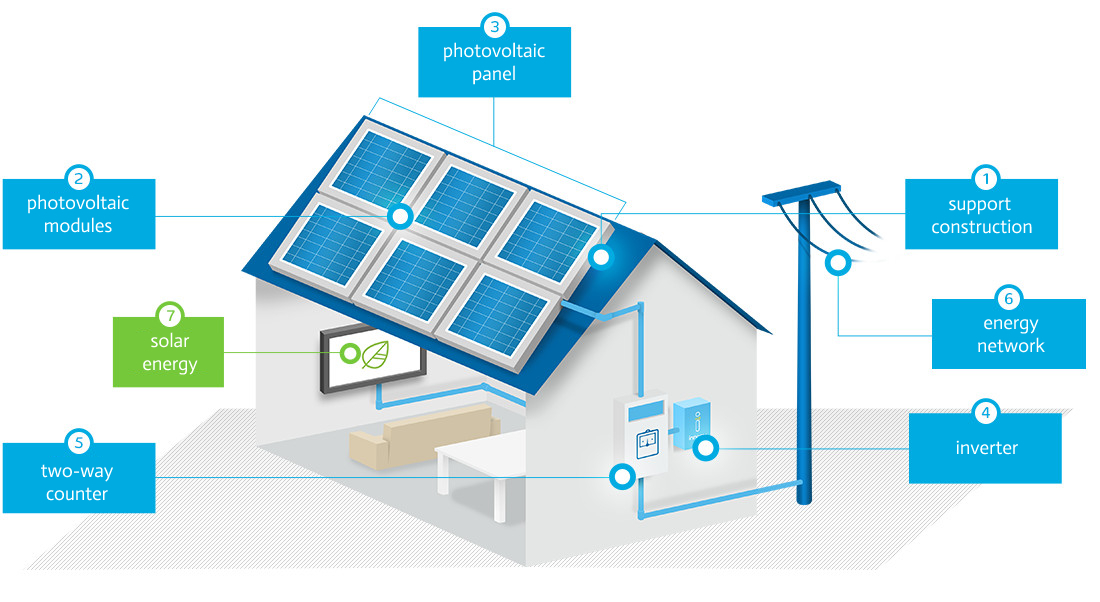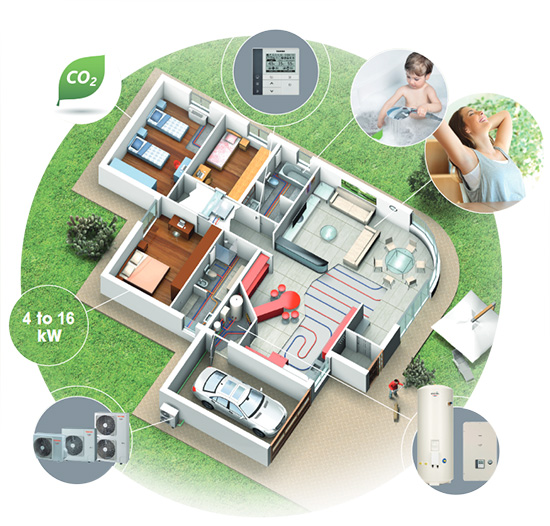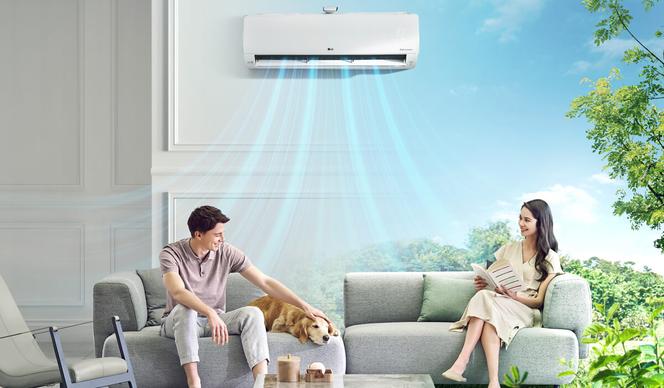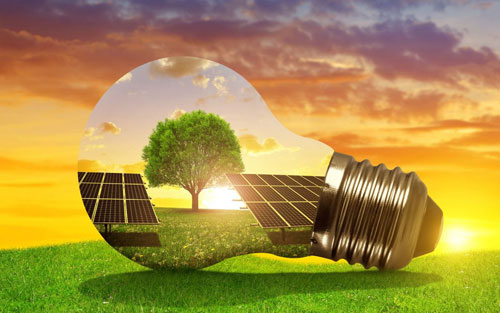
Many years
of experience
Individual
solutions
Our offer
Photovoltaics
Electricity from the sun – sounds intriguing, right? The attached graphic shows in a very simplified form the structure and principle of operation of the system in a home installation.
Photovoltaics is the process of generating electricity from free solar radiation. Currently, the development of photovoltaics is very dynamic, and the sun is the third largest source of renewable energy in the world. A properly selected and balanced system is able to provide the right amount of free electricity. By choosing this solution, you significantly reduce your fixed costs and become independent from constantly rising energy prices. For many of our clients, it is not without significance that they contribute to the common good, which is the natural environment.

Heat pumps
It is currently the most ecological solution used for central heating and hot water. It is characterized by low operating costs, and at the same time it can be completely maintenance-free. Compared to classic forms of heating, it is a very safe installation. It is not at risk of explosions, does not pose a threat to residents, and does not emit gases harmful to the environment.
The heat pump obtains energy from the natural environment (nearly 75%) and, using part of the electricity, processes heat for central heating and hot water.
To put it simply – the main task of the pump is to obtain energy from the environment, its transformation, transport and transfer of heat to the heating system.
Heat pumps are an increasingly common choice in newly built buildings. The current market situation related to the availability and prices of fossil fuels means that a lot of modernization is carried out consisting in replacing traditional boilers and furnaces and replacing them with ecological solutions.
Combining a photovoltaic installation with a heat pump is an ideal combination. Free electricity drawn from the sun is used to maintain a constant temperature in the building, providing hot water at minimal or no cost.

Air conditioning
These devices have become increasingly popular in recent years. They are no longer perceived as a luxury good, if only because of their affordable price.
The task of the air conditioner is to ensure optimal conditions of temperature, humidity and air purity in the room. Thanks to the built-in filters, the air conditioner cleans the air of some dust and volatile pollutants, which also has a positive effect on maintaining cleanliness. A properly selected and installed unit will create a microclimate suitable for comfortable rest and work.
We offer a wide range of proven and tested device models. This means that we can choose and install the right unit for virtually any room in a house, apartment or company.

Frequently asked questions
What is photovoltaics?
The word photovoltaics is a combination of two expressions – the Greek word phōs meaning light and the unit of measurement for voltage – volt. It is therefore easy to conclude that photovoltaics is simply electricity generated by the sun. But in what way?
The sun’s rays fall on the photovoltaic cells, and thanks to the photovoltaic effect discovered in 1839 by Alexander Becquerel, a direct current is generated in them. The electricity generated in this way by the panels then goes to the inverter, from where in the form of alternating current sent via wires, it powers your dishwasher, TV or fridge, thanks to the higher voltage displacing the mains electricity from the house. The electricity that is not used on an ongoing basis goes to the grid and starts to supply other consumers.
What happens to unused energy?
The bi-directional meter installed by the Energy Company measures the bi-directional current flow, i.e. it counts the electricity produced by our installation and collected from the power grid. It may happen that the energy generated by our micro power plant will be too much or too little in relation to our needs. In the first case, the excess energy is transferred to the power grid, and we can collect 80% of the energy we produce. This is related to the system of discounts for prosumers, i.e. people who generate energy for their own use. For installations whose power does not exceed 10kWp, the ratio of 1:0.8 applies under the discount system, which means that for 1kWh delivered to the grid, the owner of a micro power plant can collect 0.8 kWh. In the case of installations with a capacity between 10 and 50 kWp, we bill in the ratio of 1:0.7 – 1 kWh we give allows us to receive 0.7 kWh. In a situation where the existing demand cannot be fully covered by the use of previously generated and received energy.
How much energy does the house use?
The most important aspect when choosing the power of a photovoltaic installation is determining how much electricity we use in a year. The size of the photovoltaic installation and directly the payback period will depend on this parameter – most often, the larger the installation, the faster it “pays back”. For this purpose, electricity bills should be used – preferably summarizing the entire last year or the last months. On their basis, we are able to select the approximate power of the installation, so that it is neither too small nor oversized. At this stage, the possible increase in demand should also be taken into account, i.e. whether we intend to change the heating method to electric in the near future (e.g. install a heat pump) or buy additional energy-intensive devices (dishwasher, larger fridge, air conditioner). Each such factor that we take into account will help us plan a photovoltaic installation better.
Based on the analysis of bills received from the energy company, taking into account the rules of energy settlement in the form of discounts, we can determine the approximate power of photovoltaic panels that will be appropriate for the house. In accordance with the system of discounts for installations with a capacity of up to 10 kW, a prosumer can collect 0.8 kWh for 1 kWh delivered to the grid, in the case of installations with a capacity of 10-50 kW, the settlement takes place in the quantitative ratio of 1 to 0.7 kWh.
How to determine the power of the installation if I am just building a house?
For existing buildings, determining the power of the installation is easier, because it is matched to the average amount of electricity bills for the last year. In the case of new buildings, electricity consumption must be estimated on the basis of planned consumption, i.e. the number and type of energy-intensive devices and the number of household members must be determined. When the installation turns out to be too small during operation, there is always the possibility of expanding the system, e.g. with the use of microinverters.
What photovoltaic power - location of the house, size of the roof?
Before commencing assembly work, it is necessary to determine the installation possibilities, including the roof / ground surface, exposure of the surface to the sun, the angle of the roof slope and the possibility of shading. It is also important to evaluate the roof truss and coverage. If the conditions are unfavorable, e.g. a roof to the east and west, it is possible that it will be necessary to select a higher power of the installation so that it covers the total demand of the household for electricity.
Why is the size of the roof important? A question often asked by investors is – ” How many photovoltaic panels per 1kW?” . Approximately 3 panels are needed for this size of installation. The area that such an installation will take up is approx. 4.5 m2. In the case of 4kW, it will be over 18 m2, and 10kW – 45m2. If the roof has insufficient space, ground installation should be considered.
Too little or too much power of a photovoltaic installation - which is better?
It is best if the installation is selected so as to fully cover the needs of the farm, but this is not always possible. Installing less power only results in less savings on electricity bills. The payback period of a photovoltaic installation will remain at a similar level as in the case of an installation that fully covers the demand. Too much power of the installation means higher financial outlays for the investment and a long payback period. The savings are not greater because excess energy is lost.
Is it possible to increase the power of the installation?
If we do not plan to increase consumption in the near future, do not oversize the installation, because there is always the possibility of expanding it with additional modules.
In the case of a small increase in energy consumption, when it is enough to add 1 or 2 panels, it is often possible without replacing the inverter. However, when the expansion is to be significant, the use of microinverters is a good solution. Such a photovoltaic installation will operate independently of the original system, there is no need to replace the inverter and it is possible to choose panels of any technology or power.
Long-term warranty
Safety and comfor
The elements of photovoltaic systems we offer are covered by a long-term warranty – up to 25 years!
10 years manufacturer's warranty
25 year performance guarantee
Up to 12 years warranty on Inverters
Subsidies up to the value of the installation
Cost optimization
Stability of applied solutions
Modern technologies
Professional warranty and post-warranty service
Contact us
Customer Service Office
mail: biuro@q-allitenergy.pl
mobile: +48 784 285 654
Technical and Commercial Department
mail: kontakt@q-allitenergy.pl
mobile: +48 532 403 414



